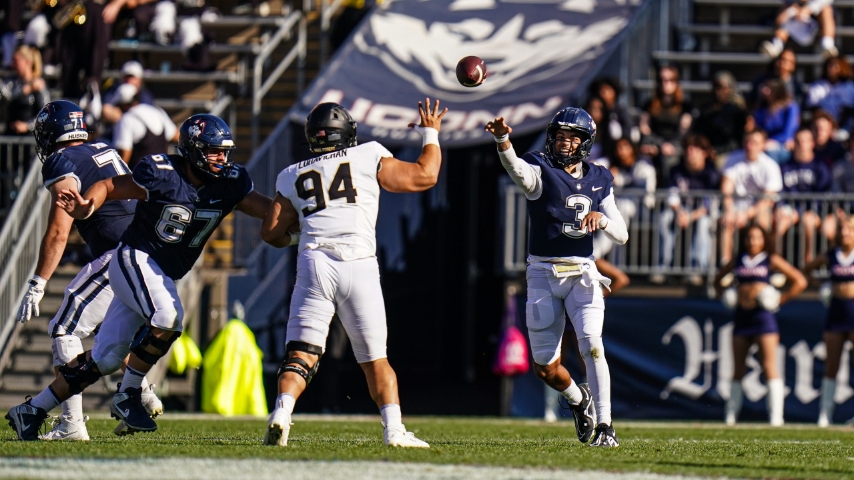
By Zach Carter
Offensive woes, specifically in the run game, plagued UConn in the loss to Wake Forest and also made the Temple game too close for comfort.
The Huskies had been dominant on their home turf predating Saturday, even including a Temple performance where the offense stumbled but still outplayed its opponent. In four games at Rentschler Field, UConn’s offense outscored opponents 187-54.
Against a tough ACC opponent — a conference UConn is now just 7-27 all-time against — in the Demon Deacons, it was expected that UConn’s scoring abilities may be slightly dimmed, but not to the extent that fans saw Saturday afternoon. Temple held the Huskies to 2.4 yards per rush in the last game but that could also be explained by the Owls selling out to stop the run and UConn managing 272 passing yards in a close, low-scoring game, and still got 99 yards on the ground.
Against Wake Forest, UConn mustered just 40 yards rushing, compared to Wake Forest’s 117. In the four home games prior, the Huskies averaged well over 200 yards per game on the ground. With rushing opportunities limited, UConn became heavily reliant on its passing, a unit that got off to a slow start before finding its rhythm late in the second half.
Quarterback Nick Evers struggled to get settled. On the team’s first offensive possession, a three-and-out was punctuated by a near-fumble after the third-down snap was low and early. On the following drive, Wake Forest linebacker Evan Slocum picked off the sophomore quarterback.
“I take full responsibility,” Evers said postgame. “If I played better, we probably would have been in a better position going into the fourth quarter.”

It was not all on Evers. Husky wide receivers had difficulty creating space against Demon Deacon defensive backs.
“I just got to find a way to be more explosive in the first half and not waiting until the second half to start making explosive plays,” redshirt junior wide receiver Jasaiah Gathings said.
Gasthings and Evers connected seven times for 75 yards in the loss. Of Evers’ 264 passing yards, just 96 came in the first half as the team managed a pair of field goals on the scoreboard. They notched two passing touchdowns in the second half.
On the defensive end, Wake Forest prepared specifically for the Huskies’ hallmark play, the outside zone. Demon Deacons head coach Dave Clawson praised his team for succeeding in this part of the game plan.
“I’m extremely proud of holding them to 40 yards rushing,” Clawson said. “That was a team that was averaging 220.”
“We did a really good job on the stretch play,” he continued. “I thought our guys maintained really good gap integrity. We did a really nice job of tackling the backs. I thought our linebackers tackled firm. We gave up some plays on the pass plays…But it allowed us at the end to make some pass calls rather than some balance calls.”
Despite UConn’s inability to consistently move the football down the field, the game was still within reach as the clock wound down. The Huskies trailed by two touchdowns at one point, facing a 20-6 deficit midway through the third quarter, and stormed back to have a chance to win.
With two minutes on the clock and two timeouts, UConn had the ball down three. On 4th and 3, lineman Brady Wayburn committed a backbreaking false start penalty, pushing UConn back into 4th and 8. On the game’s deciding play, Evers targeted Gasthings on a pass that would have extended the drive were it caught.
But Gaithings was dragged down as the ball sailed to his left. The controversial no-call prompted the UConn faithful — an announced attendance of 30,122 — to shift their chanting from ‘Let’s Go Huskies’ to emphatic boos.
“It was a hold and [pass interference],” head coach Jim Mora said postgame, mentioning the refs’ ACC affiliation.

Officiating aside, Mora acknowledged how his team’s early shortcomings played a contributing role in how the match was ultimately decided.
“[We should have] put ourselves in a position where it doesn’t come down to one play…That’s up to us to play better at the start of the game so that it doesn’t come down to that call,” Mora said. “It’s on us to play better earlier, but it’d sure be nice if it was a level playing field.”
UConn just completed the fourth of a six-game home stretch. The production from its offense was incredibly strong through the first two but the run game and consistency have trailed off in the last two games. Mora and his offensive personnel will hope to balance out the offense moving into next week’s matchup against Rice, a team that just beat UTSA 29-27.



